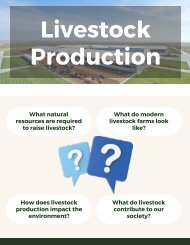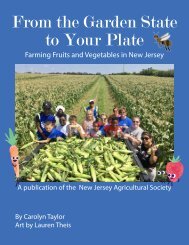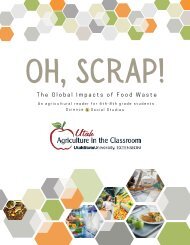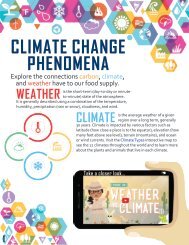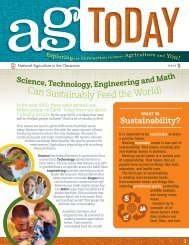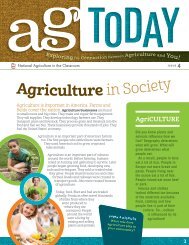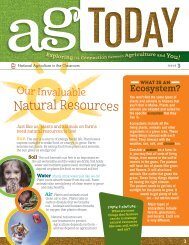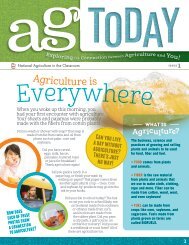Farming for Energy
Discover what energy is and where it comes from.
Discover what energy is and where it comes from.
- No tags were found...
You also want an ePaper? Increase the reach of your titles
YUMPU automatically turns print PDFs into web optimized ePapers that Google loves.
1
FARMING
WORK
ENERGY
for
ENERGY
Discover what ENERGY is and where it comes from.
comes in many forms and can accomplish a
variety of tasks. Energy is the power to do work.
is when energy is transferred to or from
an object using the application of force.
FUEL
is a substance that stores energy.
Gasoline and Diesel Fuel
give p ower to vehicles
Electricity
p owers lights
Natural Gas
is used as fuel for a hot w ater heater
Propane
is b urned in a grill to p roduce heat
What is
ENERGY
?
Energy sources can be classified as renewable or nonrenewable.
RENEWABLE
resources can be replaced
or renewed as they are used or consumed.
Examples include natural resources like sun or
wind as well as products produced on farms.
NONRENEWABLE
resources cannot
be replaced or renewed in our lifetime.
Once the resource is gone, it is gone
forever.
Energy cannot be created or destroyed.
To make energy useful, it is converted from one form to another.
SOLAR PANELS PLANTS FOOD
2
Solar panels collect energy
from the sun and then
convert it from light energy
to heat and electrical energy.
Plants collect and store
energy from the sun through
photosynthesis. Plants store
the energy until it can be
burned or converted to a
biogas and burned as a fuel.
The food we eat has a store
of energy. It is not useful to
our body until it is converted
from chemical energy into
mechanical energy through
the process of digestion.
Source of
RENEWABLE
Fuels that can be easily made or replenished;
we can never use up renewable fuels.
ENERGY
NONRENEWABLE
Fuels that cannot be easily made or replenished;
we can use up nonrenewable fuels.
BIOMASS
Anything that is alive, or anything that was alive a short
time go is called biomass. Trees, crops, garbage, and animal
waste are all biomass. Most of the biomass we use for
energy today is wood.
COAL
Coal was formed millions to hundreds of millions of years
ago from plants. Coal is often shiny, black rock. Coal is a
fossil fuel that we burn for energy.
GEOTHERMAL
Geothermal energy is heat from inside the Earth. The inside
of the Earth is very hot. Sometimes this heat comes near the
surface. We can use this heat to warm our houses. We can
generate electricity with it.
NATURAL GAS
Natural gas is a mixture of gases you cannot see, smell, or
taste. We often add an odor to it so we can smell it. It has a
lot of energy in it. You can burn it to make heat. Natural gas
is a fossil fuel.
HYDROPOWER
Hydropower is energy created by moving water. Moving
water has a lot of energy. We use that energy to generate
electricity.
PETROLEUM
Petroleum is liquid that is found underground. Sometimes
we call it oil. Oil can be as thick and black as tar or as thin as
water. Petroleum is a fossil fuel that has a lot of energy we
release when we burn it.
SOLAR
The sun provides lots of energy to the Earth. We call it solar
energy. It travels from the sun to the Earth in rays. The
energy from the sun makes rain fall, wind blow, and plants
grow.
PROPANE
Propane is the gas we use to fuel our backyard grills and
operate machines in warehouses. You cannot see, smell, or
taste it, but you can burn it to produce heat energy. Propane
is fossil fuel.
WIND
Wind is moving air. We can use the energy in wind to do
work.
URANIUM
Uranium is a mineral found in rocks in the ground. We split
uranium atoms to release energy in nuclear power plants.
3
Can FARMS
produce ENERGY
?
Most of the energy we utilize comes directly from natural resources found in the earth.
Nonrenewable energy sources like fossil fuels can’t be ‘farmed,’ they are mined from the earth.
Renewable energy resources such as wind, solar, water, and geothermal energy aren’t technically
‘farmed’ either—humans don’t have the ability to create them. However, we can harvest or collect
each of these sources of energy. That leaves us with biomass—the only source of energy that can
actually be produced on a farm.
Wood is probably the oldest source of
energy after the sun. For thousands of
years, people have burned wood to heat
their homes and cook their food. Wood is
a biomass because it comes from a tree—
which was once living. Energy was passed
from the sun, to the tree. The energy
is stored in the wood until it is burned,
releasing the energy as heat.
4
How Does Biomass Energy Work?
Converting biomass to useable forms
of energy reduces greenhouse gas
emissions in two ways. First, heat and
electrical energy is generated which
reduces our dependence on fossil fuels.
Second, greenhouse gas emissions
from the organic material itself are
significantly reduced. Rather than
allowing methane emissions from the
decaying biomass into the atmosphere,
they are trapped and converted to a
useable form of energy.
Sources of
Biomass Energy
Agricultural Crops & Residues
Straws, stems, stalks, leaves, and husks
that are leftover after a food crop is
harvested and processed.
Sewage
Similar to animal waste, energy can
be extracted from sewage using
anaerobic digestion to produce
biogas.
Forestry Crops & Residues
Pulp or timber leftover after trees are
harvested from plantations or forests.
Biomass
Sources
Municipal Solid Waste
Millions of tons of household waste
are collected each year and placed in
landfills.
Industrial Residues
Waste materials from food processing
facilities or meat processing plants.
Fruit and vegetable peelings and
leftover scraps are examples.
Animal Residues
Animal manure can be converted to
biogas using anaerobic digestion.
See how Michigan State University is generating
electricity from their food waste and animal manure
5



